Air-to-air heat pump: principle of operation, device, selection and calculations
Do you want to equip convection heating in the house, where an air-to-air heat pump is used to heat the coolant, which provides significant savings in heating costs? Agree that getting full heating in a company with hot water is almost free - a very tempting event.
But you don’t know how to build such a system in order to heat the premises in an alternative way and get hot water for domestic needs?
We will help to deal with this issue - the article highlights the principle of operation and the design of the pump. The energy of such a system will have to be spent only on the operation of the compressor, and the bulk of the heat will be taken just from the street from the atmosphere, for which we do not require money.
The advantages of its implementation in the system and significant disadvantages are also considered. Special attention is paid to the selection and calculation of the pump.
And for lovers to do everything with their own hands, we offer to build such a pump on their own using improvised materials. We provide photographic materials and video recommendations on the design and functioning of the heat air pump to help.
The content of the article:
Air-to-air heat pump characteristic
Any heat pump refers to equipment from the scope of alternative energy. He takes the thermal energy of the air masses on the street, from the surrounding space in the room, to warm it with residential and non-residential objects.
No combustible fuels are used.
Externally heat pump (TN) air-to-air similar to an inverter air conditioner, split system from the external and internal block.
And according to the principle of action, it looks more like a refrigerator, it only acts “vice versa”. But unlike both of them, this heat pump is capable of both cooling and heating the air masses in the house.
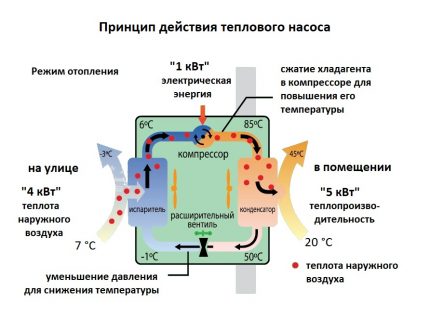
Principle of operation and internal arrangement
A simple physical phenomenon of thermodynamics is the cornerstone of the operation of air-to-air heat pumps - a liquid cools the surface with which it is dispersed during evaporation. For example, steam above a mug of hot tea shows the same effect.
An ordinary refrigerator also works on this principle. Inside it are tubes through which the refrigerant circulates under high pressure. It takes heat from the inside of the freezer, slightly warming up at the same time.
Then the collected heat is transferred to the room air through a heat exchanger (grilles behind the refrigerator).
And so that after the refrigerant cools down to operating temperatures, it is compressed in the compressor. And for the cycle of work, freon inside the system compressor-condenser-evaporator constantly changes from a gaseous state to a liquid state and vice versa.
The air heat pump functions in exactly the same way. He only takes heat from the street, and not from a closed freezer. Even if it is frosty outside, there is still a lot of thermal energy in the atmosphere.
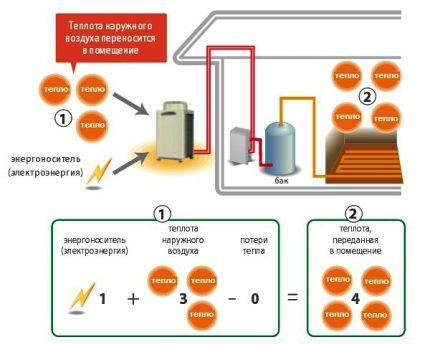
The air-to-air heat pump consists of the following elements:
- compressor;
- Evaporator with forced air blower;
- expansion valve;
- copper pipes for pumping freon between the street and the house;
- a condenser with a fan for supplying heated air to the room.
The first three elements make up the external unit, and the last refers to the inside of the heat pump. Heat-insulated copper tubes are designed for continuous movement of the coolant between these modules of the split system.
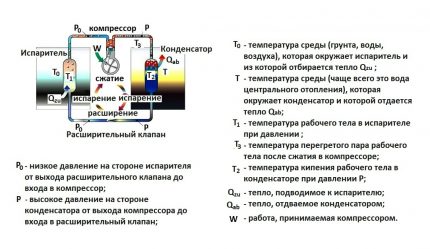
The air-to-air heat pump operation algorithm is as follows:
- The street air is drawn in by the fan into the outdoor unit and driven through the fins of the external evaporator. The freon circulating through the heat exchanger absorbs the thermal energy in it, turning into a gaseous state.
- Then the gas enters the condenser, where it is compressed. And then it is pumped through copper pipes to the indoor unit.
- In the condenser located in the house, the gas passes back into the liquid, transferring heat to the indoor air.
- Then the excess pressure is vented by means of an expansion valve, and the liquid freon is again sent to the primary evaporator.
The temperature of the freon entering the external unit is always lower than the ambient temperature. Therefore, it always takes heat from the atmosphere.
But the level of “cooling” of the coolant in the system is constant, and the outside temperature is constantly fluctuating. For this reason, in severe frosts, VT loses its effectiveness.
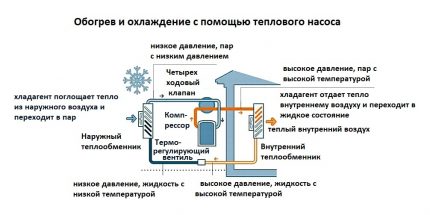
To increase the power of the heat pump, the surfaces of the condenser and evaporator are made as large as possible. And for uninterrupted operation in the winter, the outdoor heat exchanger is equipped with its own defrosting system.
Pros and cons of an air heat pump
Each technically complex system has its own advantages and disadvantages. Handouts are one thing, but in reality, heat pump owners run the risk of encountering certain problems.
Air-to-air heating / cooling plants are beneficial for a number of reasons.
The main advantages include:
- Universality. Systems allow you to heat and cool rooms depending on the purpose of the room, needs and the climatic season.
- Environmental friendliness. They make it possible to completely abandon the burning of natural gas, coal, firewood, etc., clogging the natural environment with combustion products.
- Easy installation. It is not difficult to assemble a system of components of factory production. You can build a heat pump yourself from improvised means.
- Fire safety. The process of generating heat is not associated with the use of fuel. Even violations in the operation of the installation will not be able to cause fires.
- Profitability. They are attracted by a high heat transfer coefficient at minimal cost (they produce 4–5 kW of heat per 1 kW of electricity consumed). In addition, they quickly pay off.
- Affordable for the price. The cost of factory-made systems allows you to purchase a heat pump for almost everyone. Self-made installation will be almost free.
- Convenience of operation. The most technically sophisticated device in the system is a compressor, the maintenance of which is difficult to cope. With a load typical of heat pumps, compressors rarely fail before the manufacturer's promised time.
For the organization of heating in one room is enough install split systemby hanging an external module on the facade, and a convector on the internal wall. To heat several rooms will have to equip the distribution channels of heated air.
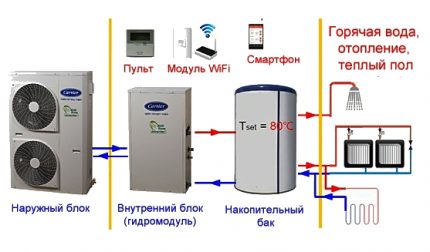
All control of the air-to-air heat pump is done by integrated automation. Particular attention will not be paid to the operation and configuration of this system. It will only be necessary to clean the air filters regularly and sometimes change them.
Among the negative sides of heat pumps are the following:
- albeit a slight, but still noisy background;
- direct dependence of system efficiency on external temperature;
- increased power consumption during cold weather on the street;
- dust constantly hanging in the air due to the continuous operation of the fan and air convection in the room;
- dependence on power supply (for uninterrupted operation, a generator is required).
At temperatures outside to -10 ° C everything works fine, the heat taken from the street is enough to create comfortable conditions in the house. But with further cooling, the pump’s cutting efficiency drops.
If the cottage is built in an area with a cold climate and severe frosts in winter, then you can not do without an additional boiler or fireplace.
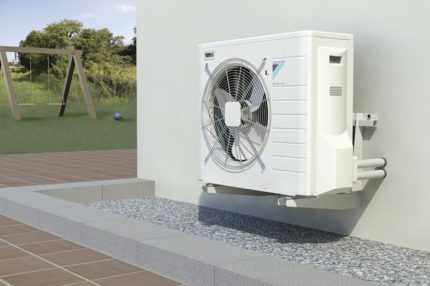
For air heating equipment such systems fit perfectly. Minimum energy consumption, installation effort and maintenance problems. But they can not heat the water.To do this, you will have to additionally install a boiler or connect to centralized networks.
Air-to-air heat pumps are the best way to heat buildings made of wood or SIW. Such buildings have low heat losses, there is enough abundance of air heat pump capacities for their heating.
The main differences from the air conditioner
Externally, the air-to-air heat pump is similar to a domestic air conditioner. But it has its own distinctive design features and specifications.
The first device is used as the main source of heating, working year-round. And the second is more intended for cooling air in the summer heat.
The main function of the heat pump is heating. However, many models can also cool room air. But in this mode of operation, they are significantly inferior to the air conditioner in energy efficiency. This is rather an extreme case of their use.
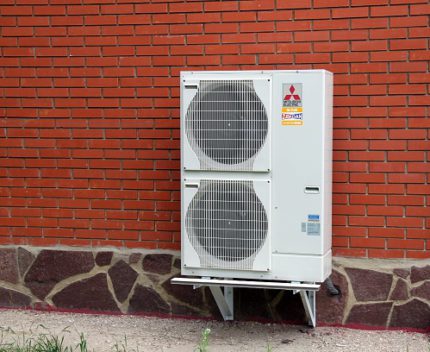
On the other hand, many inverter air conditioners can heat indoor air. But at the same time they consume much more heat pumps. Each device has its own purpose.
The use of air-to-air heaters is primarily a switch to renewable energy sources.
These systems are economically viable, despite large initial investments. Reducing heating bills pays off all upfront costs.
Selection and calculation of the heat pump
An air-to-air heat pump will be effective only if it is correctly selected. It is necessary to calculate its power in advance, depending on the quadrature of the house. And only then look at the prices of different manufacturers.
In the calculations, the coefficient of energy efficiency of the COP is used (the ratio of the power of the VT to the energy used).
Under “greenhouse conditions” it often reaches 4–5 points, and the most modern models up to 7–8. However, when the outdoor temperature drops to -15–20 ° С, this indicator drops sharply to just two.
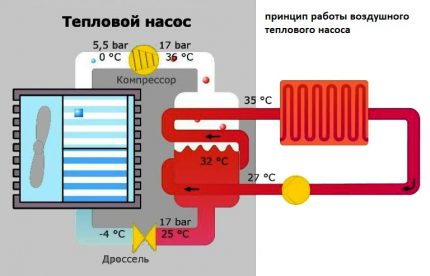
At calculation of air heating must be considered:
- thermal insulation and insolation of rooms;
- area of rooms;
- number of residents in the cottage;
- general climatic conditions of the area where the house stands.
For most homes, about ten kW of heat pump power is needed for every ten square meters. But everything here is rather arbitrary. If the ceilings above 2.7 m or the walls and windows are poorly insulated, then more heat will be required.
There are many manufacturers of air-to-air heat pumps in Asia and Europe.
Good reviews have systems from Daikin, Dimplex, Hitachi, Vaillant, Mitsubishi, Fujitsu, Carrier, Aertec, Panasonic and Toshiba. Almost all of their models are adapted to domestic operating conditions and have proven themselves well.
Even with voltage drops, they do not break, continuing to work properly after turning on the electricity.
The price of running air heat pumps varies in the range from 90 to 450 thousand rubles. Here a lot depends not only on the capacity of the unit, but also on additional functionality and the country of manufacture.
Separate models complement:
• filters for cleaning and disinfecting air;
• backup heaters;
• electric generators;
• GSM modules to control the system;
• ionizers and ozonizers.
Practice shows that in frosts below -15 ° C in rooms heated only by a heat air pump it becomes cool. And without an additional heater, the comfort in the rooms frankly does not smell.
However, in southern regions where such frosts are rare, VT is quite effective and justifies the money spent more than due to energy savings.
Homemade from an old refrigerator
It is quite difficult to assemble an air-to-air heat pump from individual compressors and condensers with your own hands without enough specialized engineering knowledge. But for a small room or greenhouse, you can use the old refrigerator.
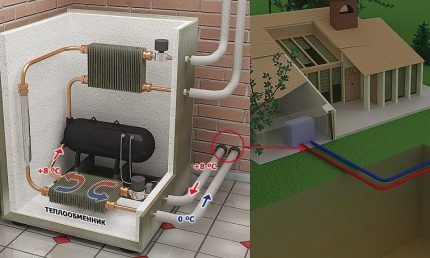
To do this, make two holes in the front door of the refrigerator. Through the first, street air will enter the freezer, and through the second lower one it will be taken back to the street.
At the same time, during the passage through the inner chamber, it will give part of the heat present in it to freon.
You can also simply refrigerate the machine into the wall with an open door to the outside, and a heat exchanger at the back to the room. But it should be borne in mind that the power of such a heater will be small, and it consumes a lot of electricity.
Indoor air is heated from the heat exchanger at the back of the refrigerator. However, such a heat pump is only able to operate at outdoor temperatures of at least plus five Celsius.
This home appliance is designed for indoor use only.

Installation of an air-to-air heat pump is extremely simple. It is necessary to install the external and internal blocks, and then connect them together by a circuit with a coolant.
The first part of the system is installed on the street: directly on the facade, on the roof or next to the building. The second in the house can be placed on the ceiling or wall.
It is recommended to install the outdoor unit a few meters from the entrance to the cottage and away from the windows, do not forget about the noise made by the fan.
And the inner one is set so that the stream of warm air from it spreads evenly throughout the room.
If you plan to heat a house with several rooms on different floors with an air-to-air heat pump, you will have to equip the ventilation duct system with forced discharge.
In this case, it is better to order the project from a competent engineer, otherwise the TN power may not be enough for all rooms.
The meter and protective device must withstand the peak loads created by the heat pump. With a sharp cooling outside the window, the compressor begins to consume electricity many times more than usual.
It is best for such an air heater to lay a separate supply line from the distribution panel.
Particular attention should be paid to the installation of tubes for freon. Even the smallest shavings inside can damage the compressor equipment.
Here you can not do without the skills of brazing copper. Refueling refrigerant generally should be entrusted to a professional in order to avoid later problems with its leaks.
Step-by-step instructions for making a heat pump from a refrigerator are described in this article.
Conclusions and useful video on the topic
The principle of operation of the split air-to-air split system:
Air heat pump in the heating system of a two-story house:
Air conditioning inverter or heat air pump - which is better?
Air-to-air heat pumps are highly efficient devices. They are easy to maintain, easy to operate and economical.
On sale now is a huge assortment of similar systems, for any home you can choose a heating installation. It is only necessary to correctly calculate its power, then it will effectively serve for many years.
What do you think about the efficiency and feasibility of using air-to-air heat pumps? Share your opinion, leave feedback on the use of units and ask questions. The comment form is located below.

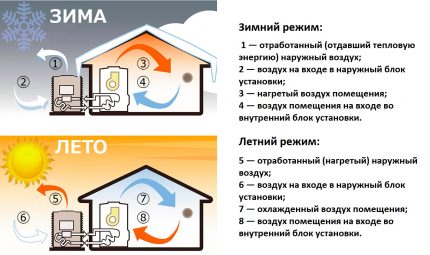
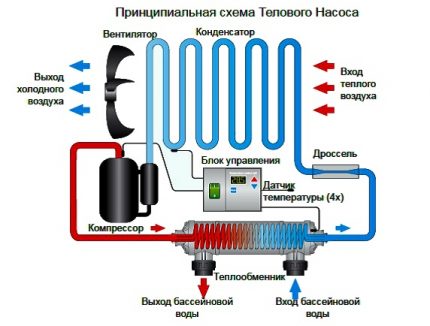
 Frenett heat pump: device and principle of operation + can you assemble it yourself?
Frenett heat pump: device and principle of operation + can you assemble it yourself? 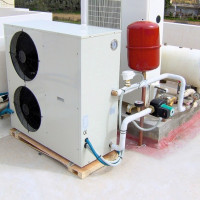 How to make an air-water heat pump: device diagrams and self-assembly
How to make an air-water heat pump: device diagrams and self-assembly  Water-water heat pump: device, principle of operation, rules for arranging heating on its basis
Water-water heat pump: device, principle of operation, rules for arranging heating on its basis 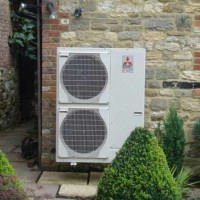 How to make a heat pump for heating a house with your own hands: the principle of operation and assembly scheme
How to make a heat pump for heating a house with your own hands: the principle of operation and assembly scheme  DIY geothermal heat pump for home heating: device, design, self-assembly
DIY geothermal heat pump for home heating: device, design, self-assembly 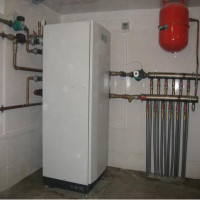 How to make a heat pump with your own hands from an old refrigerator: drawings, instructions and assembly tips
How to make a heat pump with your own hands from an old refrigerator: drawings, instructions and assembly tips  How much does it cost to connect gas to a private house: the price of organizing gas supply
How much does it cost to connect gas to a private house: the price of organizing gas supply  The best washing machines with dryer: model rating and customer tips
The best washing machines with dryer: model rating and customer tips  What is the color temperature of light and the nuances of choosing the temperature of the lamps to suit your needs
What is the color temperature of light and the nuances of choosing the temperature of the lamps to suit your needs  Replacement of a geyser in an apartment: replacement paperwork + basic norms and requirements
Replacement of a geyser in an apartment: replacement paperwork + basic norms and requirements
Due to the constant increase in energy prices, we have finally paid attention to how we can save on this type of expense due to technology. The air heat pump also has its drawbacks, but they more than pay off with the positive effect that it brings. The only negative: if days with low temperatures prevail in the region, then this pump is not for you.
We have not so few places, with a climate that is warm enough for such pumps. Take the same Black Sea coast: there are no frosts, and gas supply, especially in the foothills, is a very expensive thing. Here, such a pump is just right!
The air-to-air heat pump uses the atmosphere as an energy source. Here the dog is buried, the lower the air temperature, the less energy is produced for heating the interior. This property limits the cost-effective use of the pump to territories with t> -10 ° C. If the winter is harsh in your area, pay attention to our mother earth (below the freezing level), you can use a nearby body of water (preferably a river, a natural washing of pipes). Extra costs, but the heat in your home is worth it.
Heat pumps have one feature - the greatest efficiency is obtained by heating the coolant to relatively low temperatures - about 45 ° C. To work with conventional heating radiators, this temperature is not enough, or you will have to put large batteries in 20 sections. But for underfloor heating, this is the temperature. In conventional systems (with a gas boiler, for example), it is specially reduced to such values so as not to overheat the floor and, accordingly, the room.
And Victor and Alexander - you are not quite right. For example, cost-effective applications up to -10 are outdated information. Engineers work, invent and now have achieved on the air - air CPC system> 3 at -15g. And the work was tested at temperatures> -30g (naturally with a slight decrease in efficiency and CPC). That is, the maximum pays off in a couple of years!
Further, about heating the coolant. Engineers also worked hard. For example, they managed to squeeze more powerful compressors based on samarium magnets into the dimensions of the old blocks (which immediately almost made it possible to halve the energy consumption at the same power as motors with a squirrel-cage rotor), and the efficiency increased from the use of scroll compressors (10 percent). The internal (!) Ribbing of freon pipes and the two-row strapping of the radiators themselves made it possible to maximize the efficiency of radiators of both the external and internal units (the last top-end Daikin has a five-row indoor unit radiator). All this made it possible to reduce the difference in operating temperatures between the outdoor and indoor units, and accordingly raise the CPC.And also transfer heat pumps to the energy efficiency zone A +++!
Accordingly, in the summer you will have a very economical air conditioning, which also accelerates the payback!
I would like to ask a question, but if you put the outdoor unit underground and make a water jacket for it, or put it in a container with water?